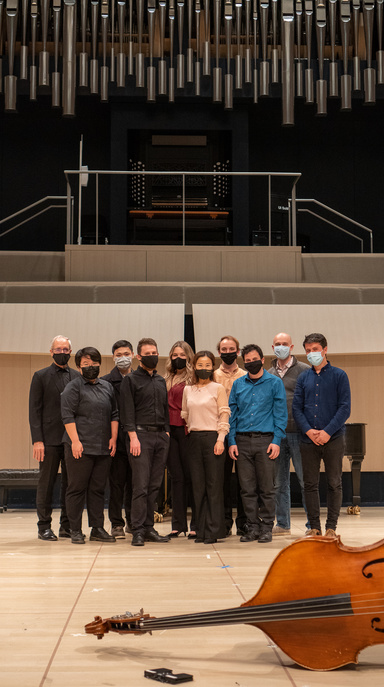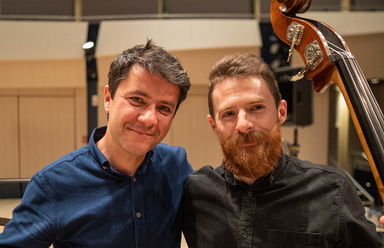CNM Ensemble Concert IV
Sunday, April 25, 2021 at 7:30p in the Concert Hall
Program
|| download program ||
Arc-en-ciel (1973) |
Giacinto SCELSI |
| Luciana Hontila, violin ShengHo Wang, violin David Gompper, conductor |
Cailloux dans l’eau (2018) |
Tristan MURAIL |
| Yi Wang, piano |
Three Phantasy Pieces (1999–2000) |
Kurt ROHDE |
| Donghee Han, viola Adrian Gomez Hernandez, violoncello Alex Waters, double bass David Gompper, conductor |
-intermission- |
Beneath the Music From a Further Room (2016) |
Davide IANNI |
| Will Yager, double bass |
Program Notes |
| Arc-en-ciel is a minimalist duo in one movement for two violins that use a process of slow transformative figures. Similar to previous pieces of Scelsi, Arc-en-ciel focuses in on the characteristics of single notes, two in this case. The piece is always utilizing microtonal movement between the two instruments, using a sliding motion in order to get from note to note. Scelsi would often experiment with the phasing of instruments in his compositions by moving one instrument before the other creating dissonance and beat effects from the two contrary pitches. The piece also creates a feeling of unity when the two violins come together and restore the tonal strength on the same pitch. Arc-en-ciel uses this method by keeping the pitch intervals to a minimum. The two violins create disparities between their two tones. This process continues throughout the piece, slowly unfolding the new figures that add complexity. |
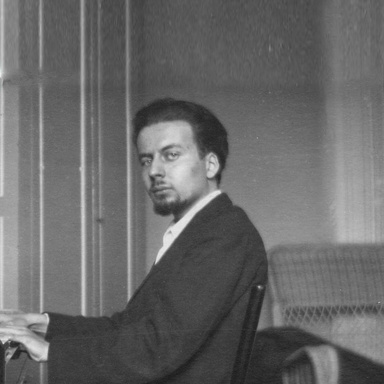
|
| Cailloux dans l’eau (2018) for solo piano is freely inspired by the famous Reflets dans l’eau, from the first book of Images for piano by Claude Debussy. These reflections, a few pebbles, carelessly thrown, will disturb them by shaking the surface of the water with a few “spectral” waves…
We will nevertheless be able to recognize the great shape of Debussy’s piece through these disturbances, while the pianistic writing is largely inspired by the techniques at work in these Images (in Reflections in the Water, or also in Gold Fish) and tries to put them at the service of my personal language. This piece is dedicated to François-Frédéric Guy. |

On his return to Paris in 1973, he co-founded the Ensemble L’Itineraire with a group of young composers and instrumentalists. The Ensemble quickly obtained wide recognition for its fundamental research in the field of instrumental playing and real-time electronics. In the 1980s, Tristan Murail used computer science to deepen his research in the analysis and synthesis of acoustic phenomena. He developed a personal computer-assisted composition system, then worked for several years with IRCAM where he taught composition from 1991 to 1997 and participated in the design of the computer-assisted composition program “Patchwork.” In 1997, Tristan Murail was appointed professor of composition at Columbia University in New York, where he taught until 2010.
Back in Europe, he continues to give masterclasses and seminars all over the world, was a visiting professor for three years at the Mozarteum University in Salzburg, and is currently a visiting professor at the Shanghai Conservatory.
|
| Three Phantasy Pieces is a composition written for viola, cello, and double bass. The piece came into existence out of necessity and opportunity to fill a program. When rehearsing for a concert that included the instrumentation of viola, cello, and double bass, Rohde and the other performers realized that one of the pieces would not be attainable for the upcoming concert. Proactively filling the hole in the program, Rohde volunteered to compose new music for this concert with the same instrumentation that was available: viola, cello, and double bass. The three movements of the piece exhibit specific motives and ostinati that are imitated and accompanied by the other instruments. The meticulous care to detail in the function of all parts allows the performers to recreate the vision Rohde had for each movement.
Rohde writes the following about Three Phantasy Pieces: “Abrupt!Fragments - Antiphony & resonance was a big preoccupation of my music from twenty years ago. I’ve always been interested in sounds that ring, and where the source of the ringing is. Solstice - I wrote this movement in twenty-four hours on the Winter Solstice. The movement is divided into two parts with a pivot in the middle where the cello and viola switch roles like the invisible moment when the end of autumn become the start of winter. Rush - This is a different approach to the concerns of antiphony and resonance that first appear in Abrupt!Fragments. The fragments are now gone, and in their place is the elongating line, repeated and growing each time towards a knotted, sometimes clotted, peak.” |
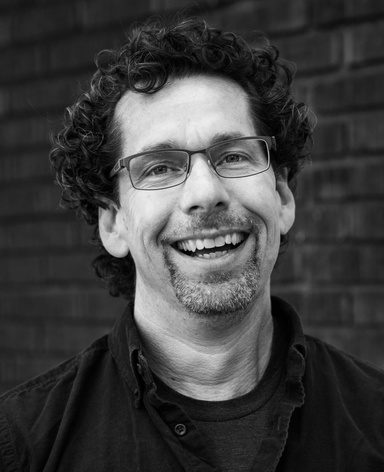
Recent projects include new works for the Hidejiro Honjoh, Lydian String Quartet, the Grossman Ensemble, and Ensemble chapp . His CD of songs using texts by poets Scott Hunter and Diane Seuss, It wasn’t a dream…, was released on Albany Records in Spring 2020. A recipient of a 2021 Creative Capital Award, Kurt is working on a collaborative project with artist Marie Lorenz and writer Dana Spiotta. Their new piece, Newtown Odyssey, will be a floating opera on the Newtown Creek addressing environmental catastrophe and justice. He is a recipient of a 2021 NEA grant with Left Coast Chamber Ensemble to collaborate with poet Donna Masini on a micro-opera based on her collection 4:30 Movie. Mr. Rohde is also collaborating with artist and filmmaker Shelley Jordon on a new project following their highly successful and recently completed installation work [Lost] In The Woods. He has also worked with artists David Humphrey & Jennifer Coates. Kurt has spearheaded two initiatives to help create opportunities for composers: The Kurt Rohde Commission Fund is a commission project supporting composers at different stages of their creative life; and Kurt Rohde’s Farewell Tour Project — PARTS 1, 2, 3, 4, 5, and 6 targets underappreciated creative voices in the new music community.
He is fascinated with the codification of failure in current culture and is trying to find ways to incorporate notions of failure and catastrophe into the way he makes work.
|
| Beneath the Music From a Further Room is the result of a deep search into the voice of the double bass and a careful selection of its possibilities. The piece carves out of the instrument a distinctive voice whose long monologue eventually starts to reverberate and inhabit the concert hall through the resonance of two bass drums sitting on stage. The piece plays with the perceptual shifting that occurs from the breaking of the concert ritual. As the bass drums take over enveloping the concert venue with their sound, the listener is subtly transported into a different sonic reality and syntax, one that appears to be removed from the performer and composer’s control. The concert ritual is slowly dissolved, and we are left to engage with sounds without a specific paradigm. |
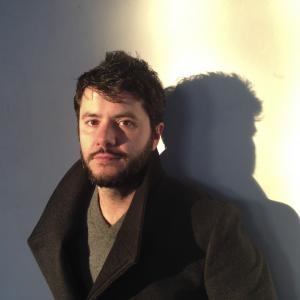
He began his musical career as a guitar player of classical, rock, jazz, and free improvisation. Ianni majored in music composition and in film scoring at Berklee College of Music and received his D.M.A. in composition and theory from Boston University. Ianni has worked with many leading composers in the United States and Europe, including Pierluigi Billone, Joshua Fineberg, Philippe Leroux, Tristan Murail, and Gunther Schuller. Ianni currently teaches Theory and Composition at New England Conservatory and classes of electronic music at Brandeis University. Since 2011, he is the artistic director of the Composit New Music Festival. |
